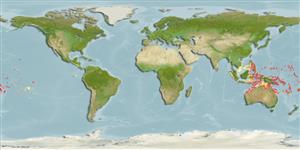| Native range | All suitable habitat | Point map | Year 2100 |

|
| This map was computer-generated and has not yet been reviewed. |
| Corythoichthys intestinalis AquaMaps Data sources: GBIF OBIS |
Issue
The species Corythoichthys waitei Jordan & Seale, 1906 is considered as valid in Eschmeyer (CofF ver. Mar. 2011: Ref. 86697) following Allen & Erdmann (2008: Ref. 74959).
Human uses
Fisheries: of no interest; aquarium: public aquariums
Phylogenetic diversity index
(Ref. 82805)
PD50 = 0.5002 many relatives (e.g. carps) 0.5 - 2.0 few relatives (e.g. lungfishes)
Trophic Level
(Ref. 69278)
3.2 ±0.2 se; Based on diet studies.
Resilience
(Ref. 69278)
High, minimum population doubling time less than 15 months (Preliminary K or Fecundity.)